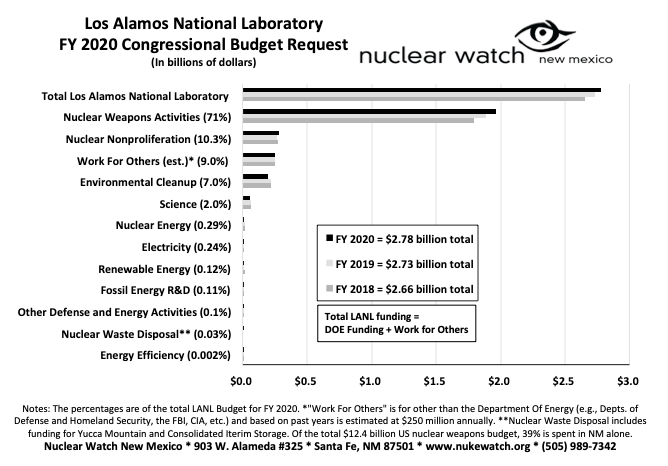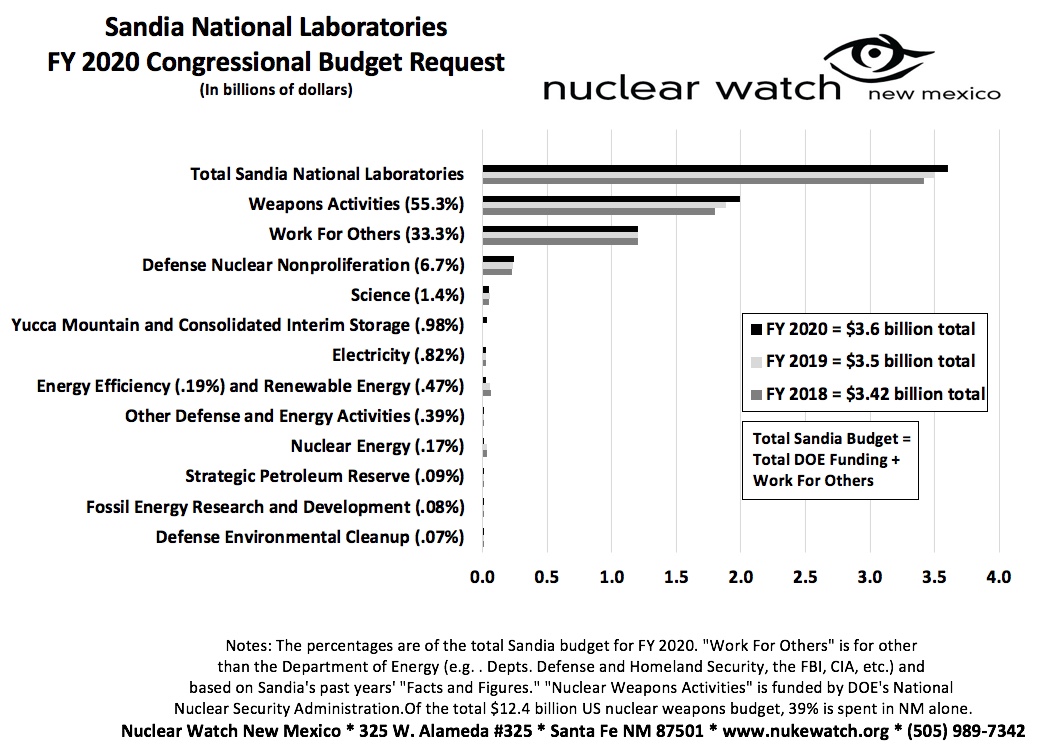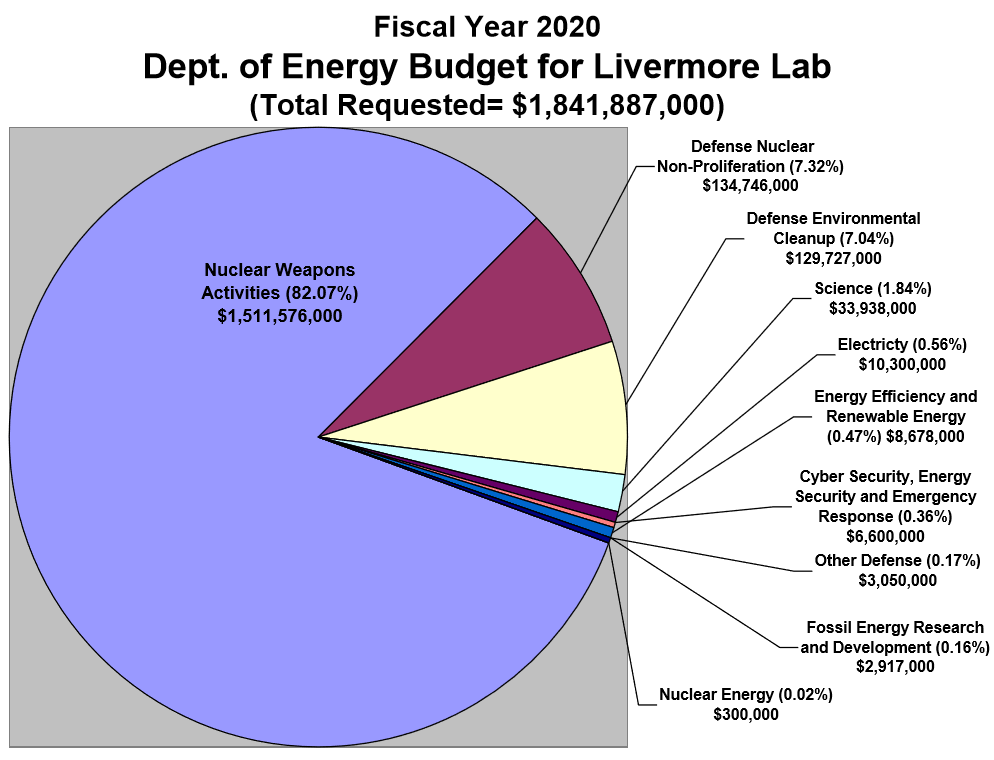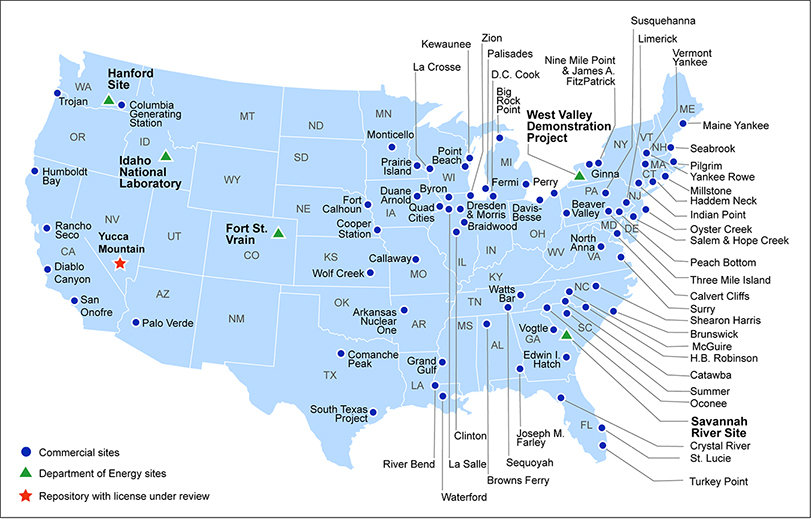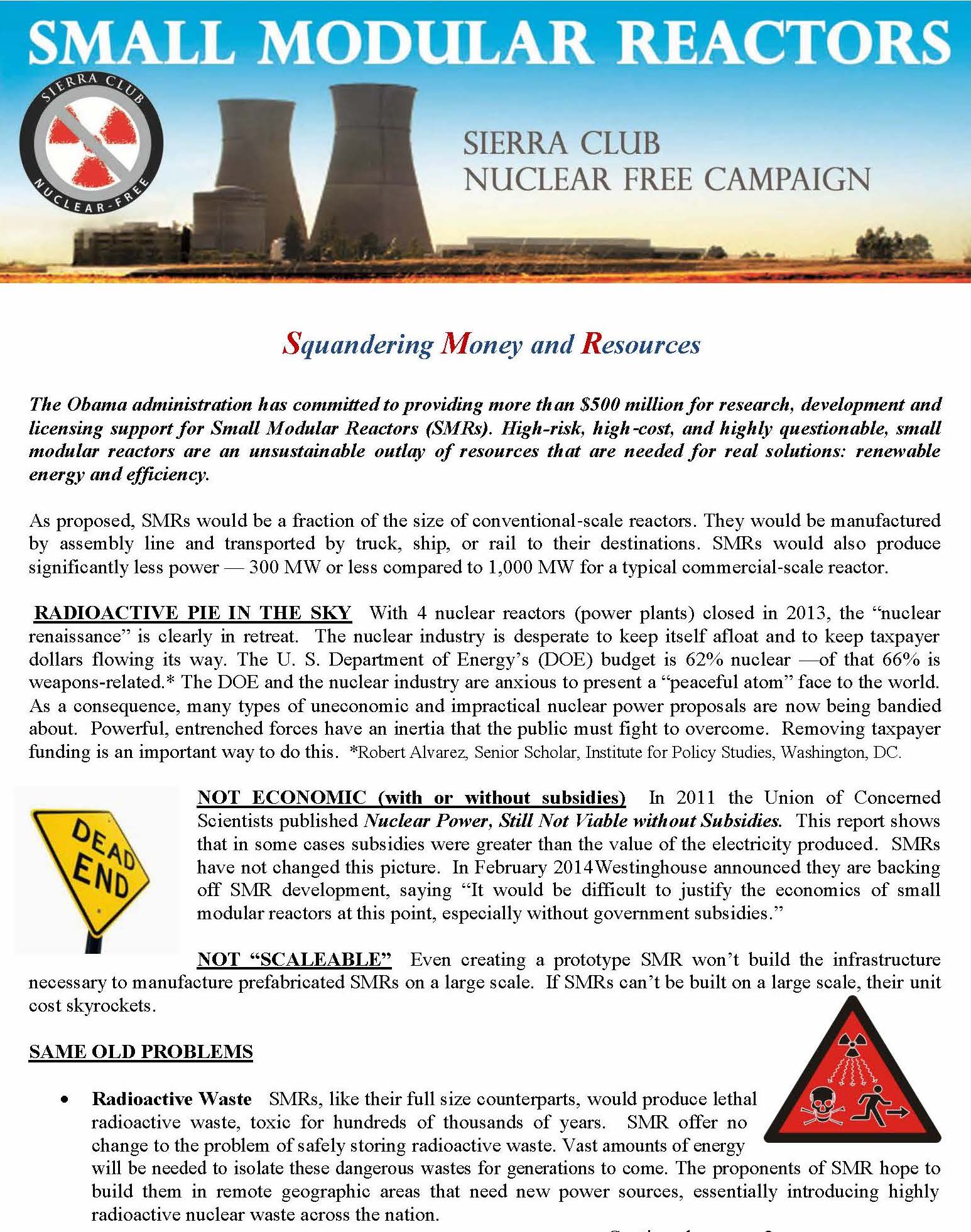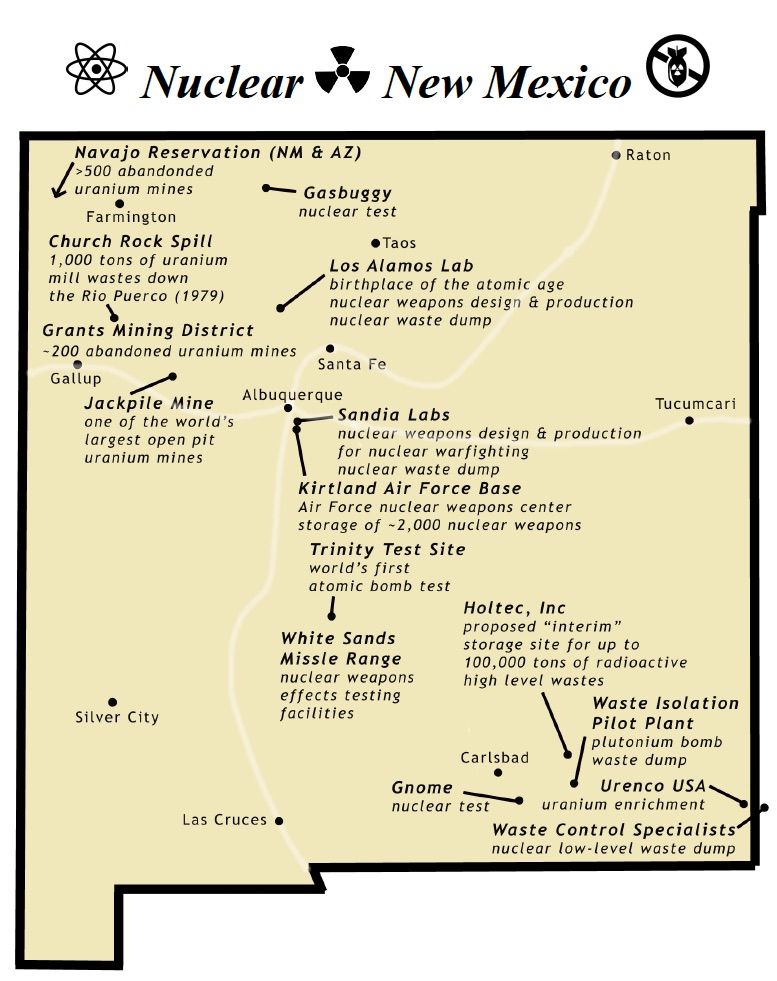Atomic Histories & Nuclear Testing
NukeWatch Compilation of the DOE/NNSA FY 2020 Budget Request – VIEW
Nothing Found
It seems we can’t find what you’re looking for. Perhaps searching can help.
LANL FY 2020 Budget Request – VIEW
Sandia FY 2020 Budget Request – VIEW
Livermore Lab FY 2020 Budget Chart – Courtesy TriValley CAREs – VIEW
Important Documents & Articles Related to Nuclear Energy Production
Most Recent
HIDDEN AGENDA: The unspoken argument for more nuclear power
Nuclear power is so slow and expensive that it doesn’t even matter whether or not it is ‘low-carbon’ (let alone ‘zero-carbon’). As the scientist, Amory Lovins, says, “Being carbon-free does not establish climate-effectiveness.” If an energy source is too slow and too costly, it will “reduce and retard achievable climate protection,” no matter how ‘low-carbon’ it is.
By Linda Pentz Gunter beyondnuclearinternational.org
 So here we are again at another COP (Conference of the Parties). Well, some of us are in Glasgow, Scotland at the COP itself, and some of us, this writer included, are sitting at a distance, trying to feel hopeful.
So here we are again at another COP (Conference of the Parties). Well, some of us are in Glasgow, Scotland at the COP itself, and some of us, this writer included, are sitting at a distance, trying to feel hopeful.
But this is COP 26. That means there have already been 25 tries at dealing with the once impending and now upon us climate crisis. Twenty five rounds of “blah, blah, blah” as youth climate activist, Greta Thunberg, so aptly put it.
So if some of us do not feel the blush of optimism on our cheeks, we can be forgiven. I mean, even the Queen of England has had enough of the all-talk-and-no-action of our world leaders, who have been, by and large, thoroughly useless. Even, this time, absent. Some of them have been worse than that.
Not doing anything radical on climate at this stage is fundamentally a crime against humanity. And everything else living on Earth. It should be grounds for an appearance at the International Criminal Court. In the dock.
Reactor at Japan’s nuclear power plant suspended over counter-terrorism demands: Reports
The third reactor at Japan’s Mihama nuclear power plant was suspended by the operator, the Kansai Electric Power company, over inability to enhance counter-terrorism infrastructure in time, the Japanese public broadcaster NHK reported on Sunday.
ANI | Tokyo • devdiscourse.com
Tokyo [Japan], October 24 (ANI/Sputnik): The third reactor at Japan’s Mihama nuclear power plant was suspended by the operator, the Kansai Electric Power company, over inability to enhance counter-terrorism infrastructure in time, the Japanese public broadcaster NHK reported on Sunday.
All the required measures to strengthen security are expected to be completed in September 2022, and the reactor might resume operations in mid-October of that year, the outlet said, citing the operator.
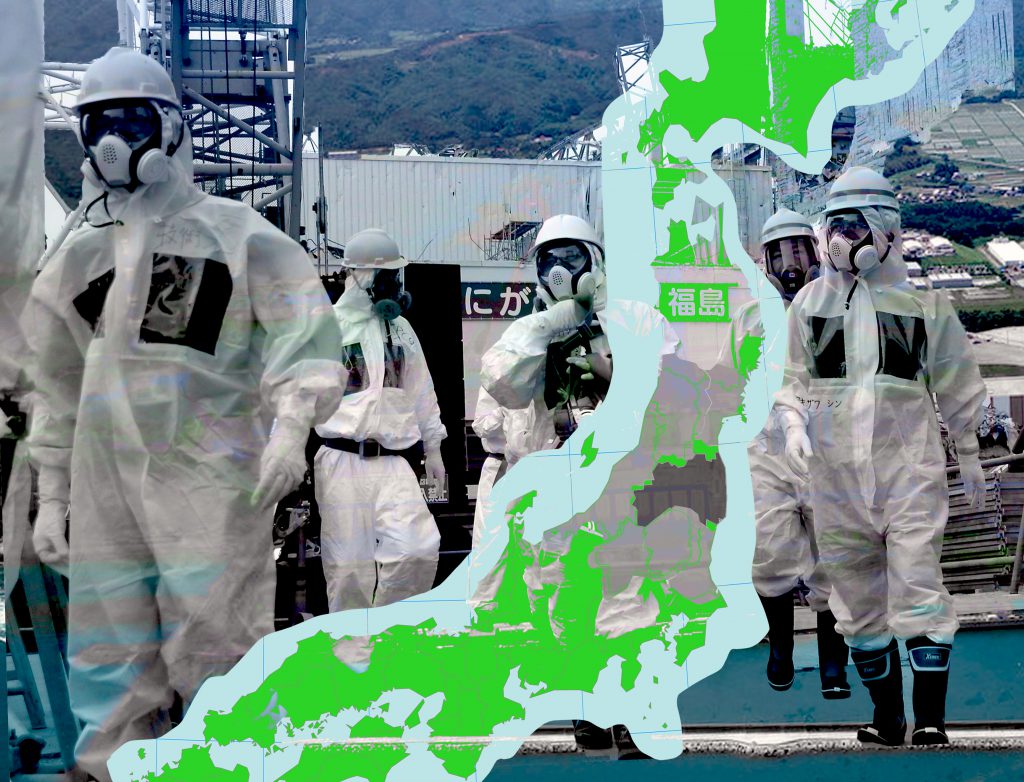
The reactor was restarted on June 23, 2021, after more than 40 years of work. The law limits the maximum lifespan of reactors to 40 years, but if additional requirements are met, a reactor can work more. Mihama’s third reactor was stopped for a decade after the Fukushima earthquake and tsunami, which in 2011 claimed over 15,000 lives, displaced thousands of people and caused a meltdown at the power plant. (ANI/Sputnik)
Carbon-Free Power Project: Don’t Continue To Delay The Inevitable
“Disclosure of these would go a long way toward improving the credibility of NuScale, UAMPS, and the community boards who are putting their own credibility on the line by subscribing to this project.
We must not forget that our ratepayer and taxpayer monies are being used to underwrite this ambitious project. We are owed transparency in return.”
BY GEORGE CHANDLER, Los Alamos
Los Alamos County Councilors,
I hope you will choose to take this unexpected off-ramp rather than continue to delay the inevitable. The UAMPS CFPP project looks to be slowly dying, apparently because not enough communities believe it to be a viable project, or perhaps because of a lack of transparency. If you choose to continue, then you can make this a better project.
I submitted the questions below to the Utilities Board prior to their July 21 meeting. The Director of the Utilities Department asked CFPP to address these questions at the July 21 meeting, and Mr. Baker and Mr. Hughes did address most of them during their presentation and under questioning by Ms. Walker. Their responses were incomplete, contradictory, and generally unsatisfying. The three of most importance are the Economic Competitiveness Test (ECT), the work on the reactor core being done by Fromatome and Enfission, and the rather curious explanations of the 54% change in output with no design changes.
Eastern Idaho nuclear reactor project downsized
Others who support the project worry about its incomplete financial support. All but one council member that day voted to continue Idaho Fall’s 5 MW commitment. But two voiced direct concern over the project not having full subscriptions. Council member Jim Francis was the sole nay vote.
“If this project works out, it’ll be great. I just wish there was a slight bit more security,” he told the Post Register in a phone interview.
A project to build a first-of-its-kind nuclear reactor in eastern Idaho has been significantly downsized.
The initial plan for the Carbon-Free Power Project was to build 12 interconnected miniature nuclear reactor modules to produce a total of 600 megawatts. It would be the first small modular reactor in the United States. After the company tasked with manufacturing the plants said it could make the reactors more power-efficient, planners reduced the project down to six module reactors that could produce 462 MW total.
“After a lot of due diligence and discussions with members, it was decided a 6-module plant producing 462 MW would be just the right size for (Utah Associated Municipal Power Systems) members and outside utilities that want to join,” said LaVarr Webb, UAMPS spokesman.
The decision was made in late June, Webb said.
The project between UAMPS and Portland-based reactor producer NuScale received $1.4 billion from the U.S. Department of Energy last year. The reactor is planned to be built on the DOE’s 890-square mile desert site west of Idaho Falls at Idaho National Laboratory. The plant is expected to be running by 2029.
“A 6-module plant allows us to get to full subscription faster, but we would have reached full subscription regardless,” Webb said of the project’s ability to achieve full financial commitment from partners. “Before joining a next-generation, first-of-a-kind nuclear plant, utilities obviously want to be certain the plant is feasible and will be built. Now that we have made significant progress, including a large cost-share award from the Department of Energy, and NuScale has received design approval from the (Nuclear Regulatory Commission), we’re seeing more and more utilities express interest in the plant.”
So far, Webb said 28 participants have committed to a total of 103 MW. But, he said, “all are currently evaluating whether to increase or decrease” their commitments. He also said “a number of utilities outside of UAMPS are considering” making a commitment.
Nuclear Power Looks to Regain Its Footing 10 Years after Fukushima
Economics may play a stronger role than fear in steering nuclear power toward a slow decline.
“The pace of nuclear technologies’ progress could also be a factor in clean-energy strategies turning away from such power generation. Small modular reactors, along with other experimental designs, are not expected to begin commercial operations (or even testing) until the 2030s at the earliest, according to the DOE. This suggests that small reactors are unlikely to make a meaningful difference in reducing carbon emissions within the next 20 years. And at that point, they will have to compete in a future energy landscape that has been transformed even further by cheaper renewables and energy-storage technologies.”
“One imagines that solar will be more ingrained and cheaper, wind may be more ingrained and cheaper, the offshore wind will be developed, maybe batteries will be better developed, and storage will be better developed,” says Allison Macfarlane, who was chair of the NRC in 2012–2014. “That’s the market nuclear will have to compete in.”
By: Jeremy Hsu| scientificamerican.com March 9, 2021
Nuclear power faces a wobbly future 10 years after an earthquake and tsunami triggered a triple reactor meltdown at the Fukushima Daiichi plant in Japan. But the industry’s unstable footing has less to do with the Fukushima accident—and more to do with how a natural gas glut and the rise of renewable power have transformed the global energy landscape.
Fukushima has certainly left its mark on the nuclear industry. When the Tohoku earthquake and tsunami occurred on March 11, 2011, there were 54 nuclear reactors in Japan. Since then about a third of them have been permanently shut down, and only nine have resumed operation.
“In Japan, [the accident is] still an outsize event,” says Edwin Lyman, director of nuclear power safety at the Union of Concerned Scientists. “It not only had direct and indirect environmental consequences that they’re still dealing with—and a price tag of hundreds of billions of dollars to clean it up—but also it shattered the confidence of the Japanese people in nuclear power, which the authorities had always assured them was totally safe.”
Additionally, the accident spurred regulatory reviews of nuclear power worldwide and accelerated a preexisting plan in Germany to completely phase out nuclear power by the end of 2022. Other countries, including Spain, Belgium and Switzerland, are in the process of doing so within the next 14 years.
Leave Nuclear to the Sun: Solar Energy & Renewables are the Source of the Future
The nuclear energy industry has had a fraught year. Well…I mean, haven’t we all…But still, it’s pleasantly surprising to see such a looming giant begin to wither and fall. The nuclear power industry is failing, as evidenced not only by the alarming reports of fraud, corruption, and other fiascos that occurred at multiple nuclear facilities over the course of 2020, but also by the numbers that prove renewables are simply better for ALL of our futures – not just the nuclear business moguls our taxpayer dollars so generously continue to bail out.
Solar to be No. 1 in US for new 2021 electricity generating capacity
25-Year Study of Nuclear vs Renewables Says One Is Clearly Better at Cutting Emissions
Nuclear power is often promoted as one of the best ways to reduce our reliance on fossil fuels to generate the electricity we need, but new research suggests that going all-in on renewables such as wind and solar might be a better approach to seriously reducing the levels of carbon dioxide in the atmosphere.
BY: DAVID NIELD| sciencealert.com
Based on an analysis of 123 countries over a quarter of a century, the adoption of nuclear power did not achieve the significant reduction in national carbon emissions that renewables did – and in some developing nations, nuclear programmes actually pushed carbon emissions higher.
The study also finds that nuclear power and renewable power don’t mix well when they’re tried together: they tend to crowd each other out, locking in energy infrastructure that’s specific to their mode of power production.
Given nuclear isn’t exactly zero carbon, it risks setting nations on a path of relatively higher emissions than if they went straight to renewables.
Two’s a crowd: Nuclear and renewables don’t mix
“If countries want to lower emissions as substantially, rapidly and cost-effectively as possible, they should prioritize support for renewables, rather than nuclear power.”
BY: University of Sussex | techxplore.com
That’s the finding of new analysis of 123 countries over 25 years by the University of Sussex Business School and the ISM International School of Management which reveals that nuclear energy programs around the world tend not to deliver sufficient carbon emission reductions and so should not be considered an effective low carbon energy source.
Researchers found that unlike renewables, countries around the world with larger scale national nuclear attachments do not tend to show significantly lower carbon emissions—and in poorer countries nuclear programs actually tend to associate with relatively higher emissions.
Revival of Renewables Sought in Debate Over Nuclear Bailout
“Most of the effects of the law at the heart of a $60 million Statehouse bribery scandal are set to take effect Jan. 1. The law generally creates or expands consumer-fueled subsidies for legacy nuclear and coal-fired power plants in Ohio and offsets those costs by rolling back and eliminating existing surcharges designed to create markets for renewable sources like wind and solar and reduce energy consumption overall.”
By: Jim Provance | limaohio.com
COLUMBUS — EDP Renewables North America, the world’s fourth-largest wind developer, invested more than $700 million into projects in Paulding and Hardin counties when Ohio first rolled out the red carpet.
But more recent signals from the state — including last year’s passage of the $1 billion bailout of two nuclear plants — have convinced the company to look elsewhere for its future investments.
“HB 6 created a false dichotomy — that Ohio must sacrifice a clean-energy future at the expense of its energy past,” Erin Bowser, EDP’s director of project management, on Wednesday told a House of Representatives select committee now considering repealing House Bill 6.
Nuclear Watch Interactive Map – U.S. Nuclear Weapons Complex
Waste Lands: America’s Forgotten Nuclear Legacy
The Wall St. Journal has compiled a searchable database of contaminated sites across the US. (view)
Related WSJ report: https://www.wsj.com
LANL’s Central Mission: Los Alamos Lab officials have recently claimed that LANL has moved away from primarily nuclear weapons to “national security”, but what truly remains as the Labs central mission? Here’s the answer from one of its own documents:
LANL’s “Central Mission”- Presented at: RPI Nuclear Data 2011 Symposium for Criticality Safety and Reactor Applications (PDF) 4/27/11
HIDDEN AGENDA: The unspoken argument for more nuclear power
Nuclear power is so slow and expensive that it doesn’t even matter whether or not it is ‘low-carbon’ (let alone ‘zero-carbon’). As the scientist, Amory Lovins, says, “Being carbon-free does not establish climate-effectiveness.” If an energy source is too slow and too costly, it will “reduce and retard achievable climate protection,” no matter how ‘low-carbon’ it is.
By Linda Pentz Gunter beyondnuclearinternational.org
 So here we are again at another COP (Conference of the Parties). Well, some of us are in Glasgow, Scotland at the COP itself, and some of us, this writer included, are sitting at a distance, trying to feel hopeful.
So here we are again at another COP (Conference of the Parties). Well, some of us are in Glasgow, Scotland at the COP itself, and some of us, this writer included, are sitting at a distance, trying to feel hopeful.
But this is COP 26. That means there have already been 25 tries at dealing with the once impending and now upon us climate crisis. Twenty five rounds of “blah, blah, blah” as youth climate activist, Greta Thunberg, so aptly put it.
So if some of us do not feel the blush of optimism on our cheeks, we can be forgiven. I mean, even the Queen of England has had enough of the all-talk-and-no-action of our world leaders, who have been, by and large, thoroughly useless. Even, this time, absent. Some of them have been worse than that.
Not doing anything radical on climate at this stage is fundamentally a crime against humanity. And everything else living on Earth. It should be grounds for an appearance at the International Criminal Court. In the dock.
Reactor at Japan’s nuclear power plant suspended over counter-terrorism demands: Reports
The third reactor at Japan’s Mihama nuclear power plant was suspended by the operator, the Kansai Electric Power company, over inability to enhance counter-terrorism infrastructure in time, the Japanese public broadcaster NHK reported on Sunday.
ANI | Tokyo • devdiscourse.com
Tokyo [Japan], October 24 (ANI/Sputnik): The third reactor at Japan’s Mihama nuclear power plant was suspended by the operator, the Kansai Electric Power company, over inability to enhance counter-terrorism infrastructure in time, the Japanese public broadcaster NHK reported on Sunday.
All the required measures to strengthen security are expected to be completed in September 2022, and the reactor might resume operations in mid-October of that year, the outlet said, citing the operator.

The reactor was restarted on June 23, 2021, after more than 40 years of work. The law limits the maximum lifespan of reactors to 40 years, but if additional requirements are met, a reactor can work more. Mihama’s third reactor was stopped for a decade after the Fukushima earthquake and tsunami, which in 2011 claimed over 15,000 lives, displaced thousands of people and caused a meltdown at the power plant. (ANI/Sputnik)
Carbon-Free Power Project: Don’t Continue To Delay The Inevitable
“Disclosure of these would go a long way toward improving the credibility of NuScale, UAMPS, and the community boards who are putting their own credibility on the line by subscribing to this project.
We must not forget that our ratepayer and taxpayer monies are being used to underwrite this ambitious project. We are owed transparency in return.”
BY GEORGE CHANDLER, Los Alamos
Los Alamos County Councilors,
I hope you will choose to take this unexpected off-ramp rather than continue to delay the inevitable. The UAMPS CFPP project looks to be slowly dying, apparently because not enough communities believe it to be a viable project, or perhaps because of a lack of transparency. If you choose to continue, then you can make this a better project.
I submitted the questions below to the Utilities Board prior to their July 21 meeting. The Director of the Utilities Department asked CFPP to address these questions at the July 21 meeting, and Mr. Baker and Mr. Hughes did address most of them during their presentation and under questioning by Ms. Walker. Their responses were incomplete, contradictory, and generally unsatisfying. The three of most importance are the Economic Competitiveness Test (ECT), the work on the reactor core being done by Fromatome and Enfission, and the rather curious explanations of the 54% change in output with no design changes.
Eastern Idaho nuclear reactor project downsized
Others who support the project worry about its incomplete financial support. All but one council member that day voted to continue Idaho Fall’s 5 MW commitment. But two voiced direct concern over the project not having full subscriptions. Council member Jim Francis was the sole nay vote.
“If this project works out, it’ll be great. I just wish there was a slight bit more security,” he told the Post Register in a phone interview.
A project to build a first-of-its-kind nuclear reactor in eastern Idaho has been significantly downsized.
The initial plan for the Carbon-Free Power Project was to build 12 interconnected miniature nuclear reactor modules to produce a total of 600 megawatts. It would be the first small modular reactor in the United States. After the company tasked with manufacturing the plants said it could make the reactors more power-efficient, planners reduced the project down to six module reactors that could produce 462 MW total.
“After a lot of due diligence and discussions with members, it was decided a 6-module plant producing 462 MW would be just the right size for (Utah Associated Municipal Power Systems) members and outside utilities that want to join,” said LaVarr Webb, UAMPS spokesman.
The decision was made in late June, Webb said.
The project between UAMPS and Portland-based reactor producer NuScale received $1.4 billion from the U.S. Department of Energy last year. The reactor is planned to be built on the DOE’s 890-square mile desert site west of Idaho Falls at Idaho National Laboratory. The plant is expected to be running by 2029.
“A 6-module plant allows us to get to full subscription faster, but we would have reached full subscription regardless,” Webb said of the project’s ability to achieve full financial commitment from partners. “Before joining a next-generation, first-of-a-kind nuclear plant, utilities obviously want to be certain the plant is feasible and will be built. Now that we have made significant progress, including a large cost-share award from the Department of Energy, and NuScale has received design approval from the (Nuclear Regulatory Commission), we’re seeing more and more utilities express interest in the plant.”
So far, Webb said 28 participants have committed to a total of 103 MW. But, he said, “all are currently evaluating whether to increase or decrease” their commitments. He also said “a number of utilities outside of UAMPS are considering” making a commitment.
Nuclear Power Looks to Regain Its Footing 10 Years after Fukushima
Economics may play a stronger role than fear in steering nuclear power toward a slow decline.
“The pace of nuclear technologies’ progress could also be a factor in clean-energy strategies turning away from such power generation. Small modular reactors, along with other experimental designs, are not expected to begin commercial operations (or even testing) until the 2030s at the earliest, according to the DOE. This suggests that small reactors are unlikely to make a meaningful difference in reducing carbon emissions within the next 20 years. And at that point, they will have to compete in a future energy landscape that has been transformed even further by cheaper renewables and energy-storage technologies.”
“One imagines that solar will be more ingrained and cheaper, wind may be more ingrained and cheaper, the offshore wind will be developed, maybe batteries will be better developed, and storage will be better developed,” says Allison Macfarlane, who was chair of the NRC in 2012–2014. “That’s the market nuclear will have to compete in.”
By: Jeremy Hsu| scientificamerican.com March 9, 2021
Nuclear power faces a wobbly future 10 years after an earthquake and tsunami triggered a triple reactor meltdown at the Fukushima Daiichi plant in Japan. But the industry’s unstable footing has less to do with the Fukushima accident—and more to do with how a natural gas glut and the rise of renewable power have transformed the global energy landscape.
Fukushima has certainly left its mark on the nuclear industry. When the Tohoku earthquake and tsunami occurred on March 11, 2011, there were 54 nuclear reactors in Japan. Since then about a third of them have been permanently shut down, and only nine have resumed operation.
“In Japan, [the accident is] still an outsize event,” says Edwin Lyman, director of nuclear power safety at the Union of Concerned Scientists. “It not only had direct and indirect environmental consequences that they’re still dealing with—and a price tag of hundreds of billions of dollars to clean it up—but also it shattered the confidence of the Japanese people in nuclear power, which the authorities had always assured them was totally safe.”
Additionally, the accident spurred regulatory reviews of nuclear power worldwide and accelerated a preexisting plan in Germany to completely phase out nuclear power by the end of 2022. Other countries, including Spain, Belgium and Switzerland, are in the process of doing so within the next 14 years.
Leave Nuclear to the Sun: Solar Energy & Renewables are the Source of the Future
The nuclear energy industry has had a fraught year. Well…I mean, haven’t we all…But still, it’s pleasantly surprising to see such a looming giant begin to wither and fall. The nuclear power industry is failing, as evidenced not only by the alarming reports of fraud, corruption, and other fiascos that occurred at multiple nuclear facilities over the course of 2020, but also by the numbers that prove renewables are simply better for ALL of our futures – not just the nuclear business moguls our taxpayer dollars so generously continue to bail out.
Solar to be No. 1 in US for new 2021 electricity generating capacity
25-Year Study of Nuclear vs Renewables Says One Is Clearly Better at Cutting Emissions
Nuclear power is often promoted as one of the best ways to reduce our reliance on fossil fuels to generate the electricity we need, but new research suggests that going all-in on renewables such as wind and solar might be a better approach to seriously reducing the levels of carbon dioxide in the atmosphere.
BY: DAVID NIELD| sciencealert.com
Based on an analysis of 123 countries over a quarter of a century, the adoption of nuclear power did not achieve the significant reduction in national carbon emissions that renewables did – and in some developing nations, nuclear programmes actually pushed carbon emissions higher.
The study also finds that nuclear power and renewable power don’t mix well when they’re tried together: they tend to crowd each other out, locking in energy infrastructure that’s specific to their mode of power production.
Given nuclear isn’t exactly zero carbon, it risks setting nations on a path of relatively higher emissions than if they went straight to renewables.
Two’s a crowd: Nuclear and renewables don’t mix
“If countries want to lower emissions as substantially, rapidly and cost-effectively as possible, they should prioritize support for renewables, rather than nuclear power.”
BY: University of Sussex | techxplore.com
That’s the finding of new analysis of 123 countries over 25 years by the University of Sussex Business School and the ISM International School of Management which reveals that nuclear energy programs around the world tend not to deliver sufficient carbon emission reductions and so should not be considered an effective low carbon energy source.
Researchers found that unlike renewables, countries around the world with larger scale national nuclear attachments do not tend to show significantly lower carbon emissions—and in poorer countries nuclear programs actually tend to associate with relatively higher emissions.
Revival of Renewables Sought in Debate Over Nuclear Bailout
“Most of the effects of the law at the heart of a $60 million Statehouse bribery scandal are set to take effect Jan. 1. The law generally creates or expands consumer-fueled subsidies for legacy nuclear and coal-fired power plants in Ohio and offsets those costs by rolling back and eliminating existing surcharges designed to create markets for renewable sources like wind and solar and reduce energy consumption overall.”
By: Jim Provance | limaohio.com
COLUMBUS — EDP Renewables North America, the world’s fourth-largest wind developer, invested more than $700 million into projects in Paulding and Hardin counties when Ohio first rolled out the red carpet.
But more recent signals from the state — including last year’s passage of the $1 billion bailout of two nuclear plants — have convinced the company to look elsewhere for its future investments.
“HB 6 created a false dichotomy — that Ohio must sacrifice a clean-energy future at the expense of its energy past,” Erin Bowser, EDP’s director of project management, on Wednesday told a House of Representatives select committee now considering repealing House Bill 6.

